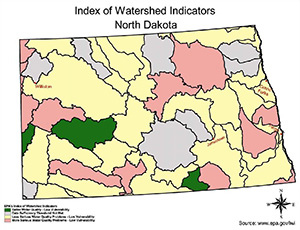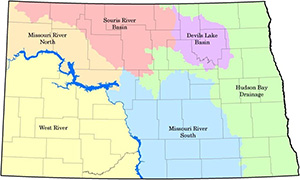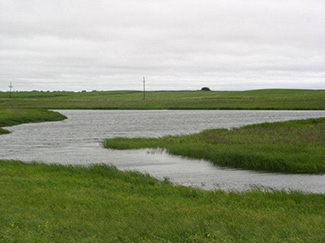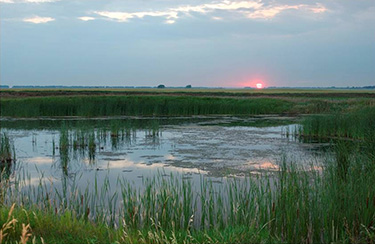Awards
Exemplary Ecosystem Initiatives — 2011
North Dakota: North Dakota Wetland Mitigation Banking Guidance Document

Figure 1. Prior to development of the North Dakota Wetland Mitigation Banking Guidance Document, watersheds were organized by Hydrologic Unit Codes (HUCs). Map depicts HUC8 Regional Service Areas.
Source: Federal Highway Administration, North Dakota Division
The North Dakota Wetland Mitigation Banking Guidance Document establishes guidelines specific to North Dakota to promote wetland mitigation banking and to establish a consistent, statewide method of mitigation banking. The Guidance Document presents methods for developing connected wetland networks and offers flexibility to agencies and others participating in projects that affect these environments.
In establishing the guidance document, multiple agencies partnered together to form the North Dakota Interagency Review Team (NDIRT). NDIRT participants include:
- Federal Highway Administration, North Dakota Division
- U.S. Environmental Protection Agency, Region 8
- U.S. Army Corps of Engineers, North Dakota Regulatory Office
- U.S. Fish and Wildlife Service, Ecological Services, North Dakota Field Office
- Natural Resources Conservation Service
- North Dakota Game and Fish Department

Figure 2. The new Regional Service Areas (RSAs) provide for a more inclusive way of thinking about watersheds. The map depicts these new RSAs.
Source: Federal Highway Administration, North Dakota Division
North Dakota Department of Transportation, while not a formal member of NDIRT, also provided valuable assistance by serving as a mitigation bank sponsor.
The Guidance Document focuses on three specific topics: geographic applicability, mitigation methods, and credit ratios. As wetland mitigation efforts work best in the areas they impact, the Guidance Document names six regional service areas (RSAs) to define the recommended watersheds for maximum geographic applicability. These RSAs replace the Hydrologic Unit Code (HUC) system, which formerly assigned eight-digit codes to over 50 watersheds in North Dakota. The RSA system provides a streamlined method for integrating watershed restoration efforts. The Guidance Document also discusses particular mitigation methods and the ways in which they link to the credit system and credit ratios further detail how mitigation credits are created and calculated.
The North Dakota Wetland Mitigation Banking Guidance Document provides a cost-effective and efficient way to support mitigation efforts, with the intention that more agencies and organizations will begin to use mitigation banking as the preferred mitigation method. The Guidance Document showcases State-specific procedures, and promotes mitigation banking as a means to support both project development and environmental protection.
For more information, contact Mark Schrader, Federal Highway Administration, North Dakota Division, at mark.schrader@dot.gov.

Figure 3: The North Dakota Wetland Mitigation Guidance Document provides a clear outline for establishing successful wetland mitigation sites like the one pictured above.
Source: Federal Highway Administration, North Dakota Division

Figure 4: The use of mitigation banks in North Dakota allows for connected wetlands restoration efforts rather than individual mitigation sites, as pictured in the wetland mitigation bank above.
Source: Federal Highway Administration, North Dakota Division

